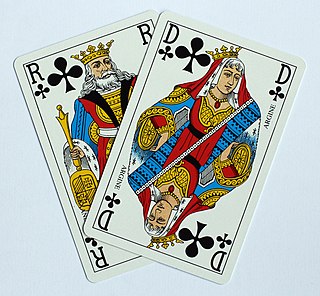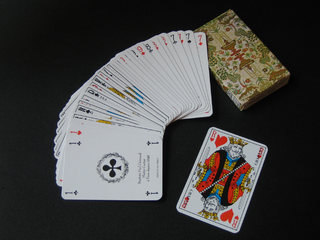
Contract bridge, or simply bridge, is a trick-taking card game using a standard 52-card deck. In its basic format, it is played by four players in two competing partnerships, with partners sitting opposite each other around a table. Millions of people play bridge worldwide in clubs, tournaments, online and with friends at home, making it one of the world's most popular card games, particularly among seniors. The World Bridge Federation (WBF) is the governing body for international competitive bridge, with numerous other bodies governing it at the regional level.

A trick-taking game is a card or tile-based game in which play of a hand centers on a series of finite rounds or units of play, called tricks, which are each evaluated to determine a winner or taker of that trick. The object of such games then may be closely tied to the number of tricks taken, as in plain-trick games such as contract bridge, whist, and spades, or to the value of the cards contained in taken tricks, as in point-trick games such as pinochle, the tarot family, briscola, and most evasion games like hearts. Trick-and-draw games are trick-taking games in which the players can fill up their hands after each trick. In most variants, players are free to play any card into a trick in the first phase of the game, but must follow suit as soon as the stock is depleted. Trick-avoidance games like reversis or polignac are those in which the aim is to avoid taking some or all tricks.

Skat, historically Scat, is a three-player trick-taking card game of the Ace-Ten family, devised around 1810 in Altenburg in the Duchy of Saxe-Gotha-Altenburg. It is the national game of Germany and, along with Doppelkopf, it is the most popular card game in Germany and Silesia and one of the most popular in the rest of Poland. A variant of 19th-century Skat was once popular in the US. John McLeod considers it one of the best and most interesting card games for three players, and Kelbet described it as "the king of German card games."

Spades is a trick-taking card game devised in the United States in the 1930s. It can be played as either a partnership or solo/"cutthroat" game. The object is to take the number of tricks that were bid before play of the hand began. Spades is a descendant of the Whist family of card games, which also includes Bridge, Hearts, and Oh Hell. Its major difference as compared to other Whist variants is that, instead of trump being decided by the highest bidder or at random, the Spade suit always trumps, hence the name.
In the card game of contract bridge, to hold up means to play low to a trick led by the opponents, losing it intentionally in order to sever their communication. The primary purpose is to give as many tricks to opponents as needed to exhaust all the cards in the suit from one of their hands. If that hand regains the lead, it will not be able to put the partner on lead to cash its tricks. Hold up is one of basic techniques in play.
A (bridge) signal is a move in the card game of contract bridge in which partners defending against a contract play particular cards in a manner which gives a coded meaning or signal to guide their subsequent card play. This may also be referred to as carding. Signals are usually given with the cards from the two-spot to the nine-spot. There are three types of signals:
In trick-taking games, to ruff means to play a trump card to a trick. According to the rules of most games, a player must have no cards left in the suit led in order to ruff. Since the other players are constrained to follow suit if they can, even a low trump can win a trick. In some games, like Pinochle and Preferans, the player who cannot follow suit is required to ruff. In others, like Bridge and Whist, he may instead discard. Normally, ruffing will win a trick. But it is also possible that a subsequent player will overruff. Historically, ruff meant to "rob" i.e. exchange a card with the stock.
In contract bridge, coup is a generic name for various techniques in play, denoting a specific pattern in the lie and the play of cards; it is a special play maneuver by declarer.
Rubber bridge is a form of contract bridge played by two competing pairs using a particular method of scoring. A rubber is completed when one pair becomes first to win two games, each game presenting a score of 100 or more contract points; a new game ensues until one pair has won two games to conclude the rubber. Owing to the availability of various additional bonus and penalty points in the scoring, it is possible, though less common, to win the rubber by amassing more total points despite losing two games out of three. Rubber bridge involves a high degree of skill but there is also a fair amount of luck involved in who gets the best cards. A popular variation of rubber bridge is known as Chicago.

Belote is a 32-card, trick-taking, Ace-Ten game played primarily in France and certain European countries, namely Armenia, Bulgaria, Croatia, Cyprus, Georgia, Greece, Luxembourg, Moldova, North Macedonia, Bosnia and Herzegovina and also in Saudi Arabia. It is one of the most popular card games in those countries, and the national card game of France, both casually and in gambling. It appeared around 1900 in France, and is a close relative of both Klaberjass and Klaverjas. Closely related games are played throughout the world. Definitive rules of the game were first published in French in 1921.

Bid whist is a partnership trick-taking variant of the classic card game whist. As indicated by the name, bid whist adds a bidding element to the game that is not present in classic whist. Bid whist, along with spades, remains popular particularly in U.S. military culture and a tradition in African-American culture.

Preferans or Russian Preference is a 10-card plain-trick game with bidding, played by three or four players with a 32-card Piquet deck. It is a sophisticated variant of the Austrian game Préférence, which in turn descends from Spanish Ombre and French Boston. It is renowned in the card game world for its many complicated rules and insistence on strategical approaches.
Singaporean bridge is a re-invention of the traditional game of contract bridge deriving its name from where it is believed to have been invented, Singapore. There are many variations to the game which is primarily social, has no official book of rules and no formal organizing authority.
The trump coup is a contract bridge coup used when the hand on lead has no trumps remaining, while the next hand in rotation has only trumps, including a high one that would have been onside for a direct finesse if a trump could have been led. The play involves forcing that hand to ruff, only to be overruffed. A similar motive is met in coup en passant, where indirect finesse is used instead of direct.
These terms are used in contract bridge, using duplicate or rubber scoring. Some of them are also used in whist, bid whist, the obsolete game auction bridge, and other trick-taking games. This glossary supplements the Glossary of card game terms.
Cinch, also known as Double Pedro or High Five, is an American trick-taking card game of the All Fours family derived from Auction Pitch via Pedro. Developed in Denver, Colorado in the 1880s, it was soon regarded as the most important member of the All Fours family in the USA, but went out of fashion with the rise of Auction Bridge. The game is primarily played by 4 players in fixed partnerships, but can also be played by 2–6 individual players.
In contract bridge, various bidding systems have been devised to enable partners to describe their hands to each other so that they may reach the optimum contract. Key to this process is that players evaluate and re-evaluate the trick-taking potential of their hands as the auction proceeds and additional information about partner's hand and the opponent's hands becomes available.
Shelem, also called Rok or similar, is an Iranian trick-taking card game with four players in two partnerships, bidding and competing against each other. Bidding and trump are declared in every hand by the bidding winner. Both the name and the point structure of this game are similar to the American game Rook, there being a possible connection between the two games. Though it isn't clear from which game it is derived.

Manille is a Catalan French trick-taking card game which uses a 32 card deck. It spread to the rest of France in the early 20th century, but was subsequently checked and reversed by the expansion of Belote. It is still popular in France and the western part of Belgium.

Sjavs is a Danish card game of the Schafkopf family that is played in two main variants. In Denmark, it is a 3-player game, played with a shortened pack of 20 cards; in the Faroe Islands, where it is very popular, it is a four-hand, partnership game using a standard Piquet pack of 32 cards.








